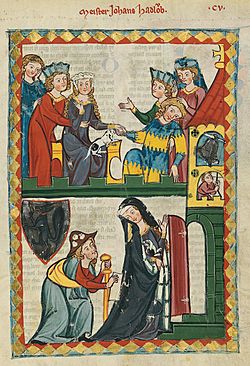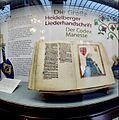Codex Manesse facts for kids
Quick facts for kids Codex Manesse |
|
|---|---|
| Heidelberg, Universitätsbiblithek, Cpg 848 | |

Folio 371r, Johannes Hadlaub
|
|
| Also known as | Große Heidelberger Liederhandschrift |
| Date | c. 1304 |
| Place of origin | Zürich |
| Language(s) | Middle High German |
| Author(s) | c. 140 named Minnesänger |
| Patron | Manesse family |
| Material | Parchment |
| Size | 426 folios |
| Format | 350 x 250 mm, 2 columns |
| Script | Textura |
| Contents | Minnesang |
| Illumination(s) | 137 whole-page miniatures, Lombardic capitals |
The Codex Manesse is a very important book of songs from the Middle Ages. It is also known as the Große Heidelberger Liederhandschrift. This book is the best source for Minnesang poetry, which was a type of love song in Middle High German.
The book was created and illustrated around 1304 in Zürich, Switzerland. It was made for the wealthy Manesse family.
The Codex Manesse is famous for its beautiful artwork. It has 137 detailed pictures, called miniatures. Each picture shows a different poet.
Today, you can find this special book at the Heidelberg University Library in Germany. In 2023, the Codex Manesse was added to UNESCO's Memory of the World list. This means it is recognized as a very important document for human history.
Contents
What's Inside the Codex Manesse?
The Codex Manesse is like a collection of greatest hits from about 135 different poets. These poets lived between the mid-1100s and early 1300s.
For each poet, there is a colorful picture of them. After their picture, you can read the words to their songs and poems.
The poets are organized in the book by their social rank. It starts with the most important people, like the Holy Roman Emperor. Then it moves down to kings, dukes, counts, and knights. Finally, it includes common people.
Most of the poems are Minnesang, which were often about courtly love. But the book also includes other types of writing. You can find fables and poems that teach lessons.
Some of the poets in the book had been dead for over a hundred years when the book was made. Others were alive at the time. Some poems were even added later, in the early 1300s.
Pictures of the Poets
The pictures in the Codex Manesse are very interesting. Some noble poets are shown wearing full armor. Their armor often has their family's colors and symbols. They might be shown in a joust (a knightly contest) or in battle.
Sometimes, the pictures show something about the poet's life. For example, Walther von der Vogelweide is shown thinking deeply. This matches how he described himself in one of his famous songs. Other times, the picture is a fun play on the poet's name.
Famous Poets in the Codex
The Codex Manesse features many important poets from the Middle Ages. Here are a few examples:
- Henry VI, Holy Roman Emperor: An emperor who was also a poet.
- Conradin: A young king.
- King Wenceslaus II of Bohemia: A king from Bohemia and Poland.
- Herr Walther von der Vogelweide: One of the most famous German poets of the Middle Ages.
- Herr Wolfram von Eschenbach: Another very important German poet.
- Herr Hartmann von Aue: A well-known poet from the 1100s.
- Tannhäuser: A poet often shown as a member of the Teutonic Order (a group of knight-monks).
- Neidhart: A popular poet known for his lively songs.
- Meister Johannes Hadlaub: A poet from Zürich. He might have helped put the whole book together!
- Meister Heinrich Frauenlob: A poet whose name means "praise of women."
Journey of the Codex Manesse
The Manesse family in Zürich paid for this amazing book to be made. Rüdiger II Manesse, who lived around 1304, likely supported its creation.
The Manesse family's power faded in the late 1300s. The book's journey after that is a bit of a mystery for a while. By the late 1500s, it belonged to Baron Johann Philipp of Hohensax. Interestingly, two of his ancestors are shown in the codex!
Later, in the 1600s, the book became part of the French royal library. It then moved to the Bibliothèque Nationale de France (the French National Library). In 1888, after a lot of discussion, the book was sold to the Bibliotheca Palatina in Heidelberg. This purchase was made possible by public donations, led by Emperor William I and Otto von Bismarck.
Today, scholars often call the Codex Manesse simply C. This is a short way to refer to it, following a system set up by a scholar named Karl Lachmann. He used A and B for two other important songbooks.
Images for kids
-
Folio 127r: Works of Walther von der Vogelweide






